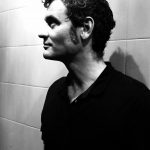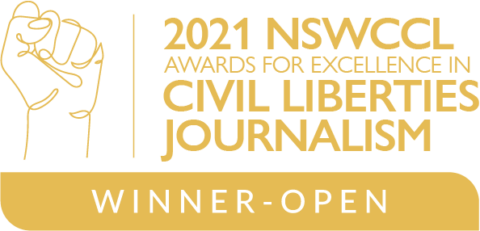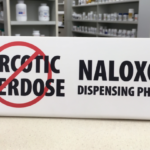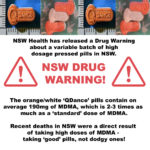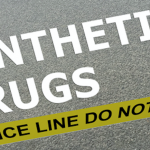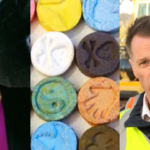A Rise in Nitazene Overdoses Requires Fixed Site Pill Testing and Take-Home Naloxone
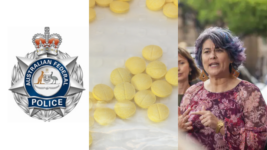
The Australian Federal Police issued a warning on Wednesday about the worrying trend in a relatively new type of street drug, a group of synthetic opioids known as nitazenes, being increasingly detected at the border, as well as being available for distribution on the local black market, which is of concern as these illicit substances are so strong overdose comes easily.
With the emergence of synthetic opioid fentanyl on the Australian streets almost two decades ago now, the warning back then was it was often being sold as heroin on the streets, which was leading to fatalities because fentanyl is about a hundred times stronger than its popular predecessor, however, when it comes to nitazenes, they’re like fentanyl on steroids.
The first time the AFP warned about the rising appearance of nitazenes was this time last year, while the current alert outlines that over the last 12 months, these substances have been sold as counterfeit pain medication, including some that appeared to be oxycodone, although nitazenes are also being detected in samples of cocaine, crystal meth, MDMA, ketamine and even vaping liquids.
The issue with these drugs being sold as less potent opioids is problem enough as far as overdoses go. Although on such occasions, naloxone, an opioid overdose reversal drug, can be applied. Yet, in the case of a life-threatening episode resulting from nitazene-laced cocaine or ecstasy, applying the naloxone cure isn’t so obvious considering the illicit substance wasn’t supposed to be an opioid.
In terms of the current nitazene crisis, AFP acting assistant commissioner Paula Hudson suggested the “just say no” approach to drugs, which has never worked, while more practical harm reduction experts are rather recommending that people keep some naloxone on hand regardless of their drug of choice, as well as calling paramedics for assistance, as soon as overdose appears likely.
Hard to detect
Nitazenes were produced by Swiss chemists back in the 1950s, as an opioid alternative to morphine, however, because of their potency, knowledge of their existence was reserved to researchers, until these drugs started appearing on European streets for recreational use in 2019, and since then, they’ve be located across the planet, and these days there are at least 13 different types of the drug.
In May last year, the AFP reported that the majority of nitazenes being located at the border were being imported via post, while this year, the agency explains that the main importation method continues to be international mail. And while nitazenes aren’t being produced locally, recently located arrivals of the drug have been posted from the United Kingdom, Canada and Hong Kong.
Nitazenes have been located locally in New South Wales, Victoria, Queensland and the Australian Capital Territory of late, according to the federal police.
But despite nitazenes even knocking fentanyl for six in terms of potency and lethality, the advantage people who use drugs have in the current climate in terms of avoiding nitazene use, compared to when the stern warnings about fentanyl were circulating a decade ago, is that these days, drug checking services are increasingly available to the public, both at music festivals and at fixed sites.
NSW held its second pill testing trial at last Saturday’s Midnight Mafia festival held on Wangal land at Sydney Olympic Park. And the only complaint made about this latest drug checking service, was similar to the gripe around the initial trial held earlier this year on Dharawal land in Wollongong, and that involved the counterintuitive continued heavy police presence and sniffer dog use at the event.
In the lead up to the 3 May pill testing service operating at Midnight Mafia, Uniting NSW.ACT director of advocacy and external relations Emma Maiden, said the next development should be the implementation of a fixed-site drug checking facility, which would allow people to ascertain whether drugs in their possession are laced with nitazenes, without first having to attend a festival to find out.
Lifesaving substance
“Nitazenes are an illicit and dangerous synthetic opioid, which can cause serious and unpredictable health effects,” explained the 7 May 2025 AFP press release, “including overdose which may present as loss of consciousness, shallow or stopped breathing, bluish-purple skin and slow or erratic pulse.”
According to Dr Marianne Jauncey, the medical director at the Uniting Medically Supervised Injecting Centre (MSIC) Kings Cross, “Overdoses are simple and easy to treat if recognised, but everyone in the sector is rightly frightened about the potential impact of nitazenes.”
Indeed, the Uniting MISC has successfully managed over 11,500 overdoses without a death since 2001.
“Nitazenes are being detected in all types of drugs,” the doctor confirmed in a statement on Thursday, “MDMA, ketamine, cocaine, methamphetamine, as well as counterfeit pharmaceuticals like Valium and oxycodone. They’re even being found in vapes.”
Sydney Criminal Lawyers contacted Dr Jauncey last year, following warnings about nitazenes not only proving deadly when sold in place of regular less potent opioids but also in terms of it appearing in a variety of party drugs, to make sure that naloxone can be used and can prove effective if a potentially nitazene-laced nonopioid substance has been consumed and the taker appears to be overdosing.
And the doctor confirmed that in such situations it is absolutely safe to apply naloxone as it’s “inert and will do no harm”, and “even if someone hasn’t taken opioids, it will be safe”, as “it has one action only, and that is to reverse any opioids.”
Signs to be aware of in these cases, Dr Jauncey continued, is when a person who has taken a drug starts to become “increasingly sedated, drowsy, harder to rouse, all the way through to being completely unresponsive”.
“They can start to turn blue, and you may notice that their breathing is shallow, infrequent or absent,” the Uniting MSIC medical director continued. “You may also notice that they have very small pinpoint pupils.”
The doctor further stressed the need to call for an ambulance in these circumstances, and she assured that regardless of what has been occurring at the scene in regard to illicit substances, paramedics don’t inform the police, which means no one present at the scene is at risk of being charged with a drug offence, when seeking help to save a friend’s life.
Ignorance is ignorant
Drug checking services have been available in the ACT, NSW, Victoria and Queensland. However, since premier David Crisafulli took office in Queensland last October, he’s been promising to end the lifesaving intervention that is drug checking.
The retrograde leader of the northern state officially ended pill testing in that jurisdiction last Sunday and that included the fixed site service that had been operating within the community.
And when the Liberal Nationals leader was quizzed about deadly nitazenes being available on the black market, he explained that this only gave him more impetus to end the scourge of drug checking services that tend to save the lives of young people. But then again, it must be remembered that Crisafulli is a grown man who’s building his career on locking up kids as young as 10 in prison.
Jauncey, however, is a lot more cluey than the leader of Queensland it would seem, as the trained medical professional considers informing the public about their options leads to more positive outcomes.
Since early 2016, naloxone, the drug that can reverse an opioid overdose, has been available over-the-counter at chemists. The doctor adds that about 60 percent of pharmacies are actually stocking the substance, which can be obtained free-of-charge, and there’s a map listing the pharmacies across Australia providing take home naloxone that appears on the Department of Health website.
“We need widespread drug checking services, freely available and accessible right across the country,” Dr Jauncey underscored. “We also need greater awareness of the Take Home Naloxone program, ensuring that people are aware of this lifesaving drug being freely available from pharmacies around the country.”
“Surely it makes sense to put information and power in the hands of people most at risk,” the doctor added in conclusion.
